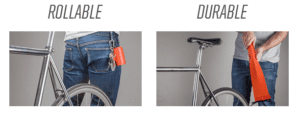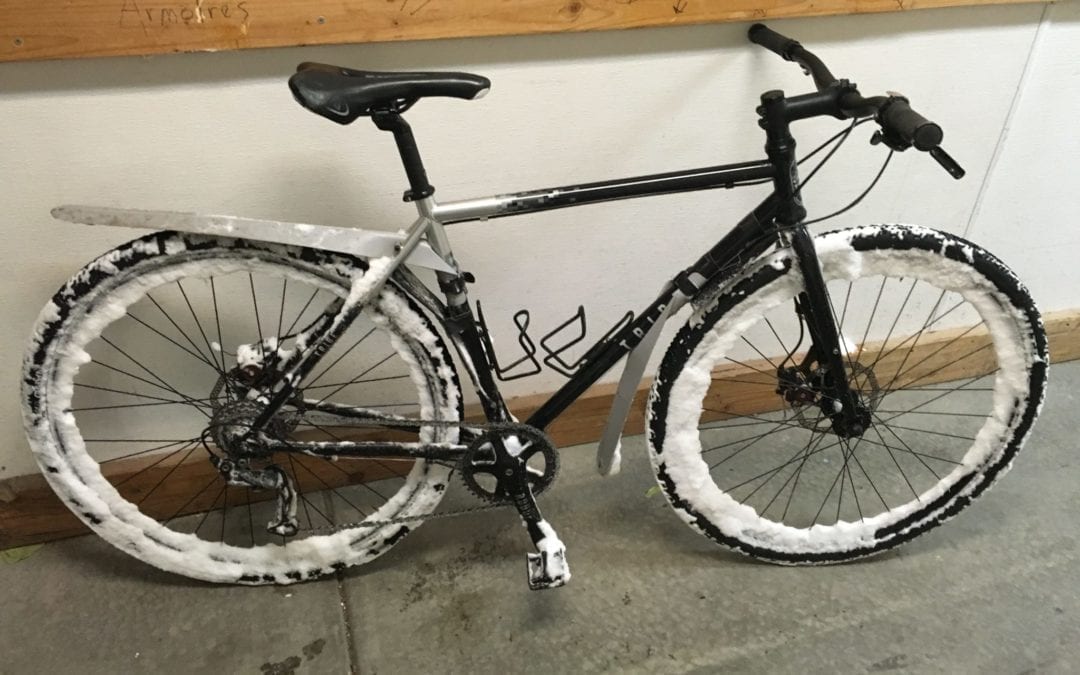There’s No Bad Weather, Just Bad Clothes
I sold my car over two years ago, so I commute on my bike year round. After several winters of bike commuting, I have a pretty good idea of what to wear for every temperature range and have amassed a large amount of winter gear. But, I do not plan to tell you my riding outfits for specific temperatures for a couple reasons. First, I am naturally warmer than most people, and everybody regulates body temperature differently. Second, everybody has a large variety of clothes in their closet that should already work and will not own what I own. My goal is to give you the tips and knowledge necessary to tackle the colder days and be able to increase the amount of days you commute throughout the year. At the end, I will give a list of clothing I really enjoy and would recommend.
While I am a firm believer you do not need to spend much money on new or different winter clothes, I recommend wool to everybody who wants to commute in the winter. Technology has created some pretty nice synthetic materials, but I am not convinced any of them are better than merino wool. Wool regulates temperature with the body incredible well, can still help keep you warm when it gets wet, wicks moisture from your body, and is naturally fairly smell proof. I own a pair of mid-weight wool leggings. I have biked down into single digits wearing those leggings, and I have sat in a classroom at 70 degrees for nearly 3 hours. I was comfortable in both situations. This is also why I love wool socks. I can wear them all day and my feet never feel too hot or too cold. Wool has been key to commuting comfortably in varying temperatures throughout the winter.
An important part of bike commuting is layering. Layers allow you to make minor adjustments for the temperature range of your morning commute and evening commute. It even allows adjustments mid-ride if you misjudged your outfit. If you place your warmest jacket on over your t-shirt and begin to get to hot, there is not much to do about it because you will either be hot or way too cold. Layers let you fine tune or easy adapt an outfit. Often morning or evening commutes will be at different temperatures, but it is easy to take an extra long sleeve shirt to wear on the way home if it will be colder rather than swapping jackets. Even if you have to take a full extra pull over to add because of Colorado’s drastic temperature swings, a pull over sweater is smaller than a different large jacket. As stated earlier, I recommend a wool base layer and then different layers based on need with a windproof and/or waterproof outer layer on the colder days. You generate a considerable amount of heat while riding, and it is often lost due to the wind rushing through your clothes. By simply adding a windproof layer, it can make any outfit significantly warmer. I will wear a wool base-layer and t-shirt into the mid-to-low 40’s fairly comfortably. The other day I simply added my Patagonia rain shell that is water and windproof (not very breathable). I was sweating at 22 degrees outside. An outer-layer that removes wind-chill is vital to cold weather and many of those layers can pack nice and neat into themselves.
From my experience, if you are wearing enough clothes to be warm standing around outside, you have too much on. Once you start biking, you will generate a considerable amount of heat that you need to account for. I assume I will be a little cold for the first mile to mile and a half. After 6 months of commuting to the bike shop, I have a “spot” for each direction of my commute that I can evaluate if I am too hot or too cold. It is long enough into the ride for my body to have warmed up. If I am not warm by that point, it generally means I need to add another layer. If I am warm, I will be fine. If I am hot, I need to shed a layer or be a sweaty mess by the time I reach my destination. The more you commute, the more you get used to what to wear at different temperatures. I check my weather app before I leave for my commute and now know what to wear at each temperature meaning I rarely have to stop to add or remove a layer now.
Always be prepared for the drastic changes in weather. I prefer to not wear windproof materials unless it is very cold. So I tend to have a wool base layer, then a long sleeve shirt, running pull over, or light hoodie. However, I always keep a windproof jacket that packs small into a little ball in my backpack. So if any day I am underdressed, I can easily throw that over what I have and it should help quite a bit. If you always prefer a windproof layer, maybe keep a light-weight wool base layer in your bag as an extra layer to add. I never plan to use this specific extra layer. I use a weather app that gives hour by hour temperatures for the day. If the temp is expected to drop 15 degrees when I am at work, I will bring the clothes necessary to ride home. This layer is for when the weather does not follow expectations because let’s be honest, the weather apps are not always accurate.
Finally, Denver provides a relatively mild winter to commute in. If you do not feel comfortable riding in snow a few days a year with your regular tires and do not have a car, then there is always the option of studded tires. Schwable makes their Marathon Plus Tire with metal studs to better grip in snow and ice. However, I find that my regular knobby tires that I use on my gravel bike do just fine in the snow as long as I lightly brake and don’t make too hard of turns. Studded tires are not cheap and are definitely louder on dry pavement, so I do not recommend them unless you plan to ride every snow day and will not feel comfortable or safe otherwise. Besides tires, disc brakes are definitely a better winter setup compared to rim brakes. Again, this is purely due to wet rims in the snow/ice. Cold does not change any of this, so if you are not planning to ride on those bad weather days, do not worry about which brakes you have. While I do not believe you need to change your tires or brakes for basic winter commuting, I would recommend fenders.
Musgard Portable Fenders:


Our snow does not stick like other cities further north, meaning that the paths are often wet with snow or the snow on the sides melting onto the path. Fenders will help keep your feet and back dry and can help prevent ice build up on your cassette, especially in all of our wet, slushy spring snow days. I personally do not have permanent fenders, and I use easily removable fenders (pictured above) that better fit my bike. Overall, you should be able to commute most days of the year, even if you avoid the days it snows, with your current bike because the snow on our paths usually melts quickly.
Winter commuting can be done by anybody who is willing to brave the elements and has a little knowledge. By nature of living in a colder environment already, you should be ready to tackle winter commuting. If you want to buy something, buy wool. To become better at winter commuting, keep riding. The more you ride, the better you will layer and the more your body adjusts to the temperature. If you ever have questions and want to get into it more, feel free to send me an email at neal@goodturncycles.org. This is my third winter without a car, and I have had the pleasure of riding to work during every major snow storm we have had this year.
List of top gear I would recommend:
Merino Wool Midweight Leggings by Minus 33
Midweight Base Layer by MeriWool

